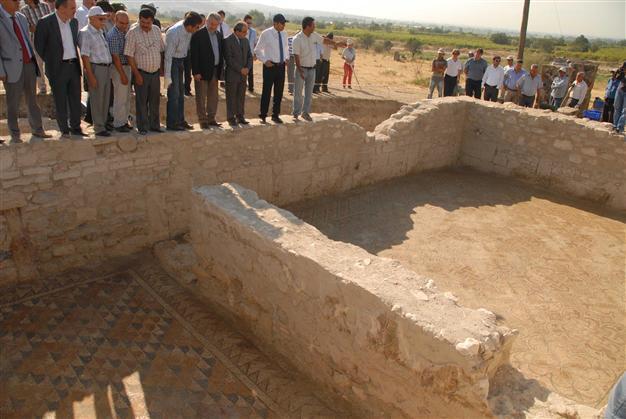House adorned with mosaics discovered in ancient Lycian city of Aegean province
DENİZLİ - Anadolu Agency

Archaeologists found a house covered with mosaics in the ancient city of Tripolis. The house is fully covered with mosaics, which are very well-protected. ‘The house’s floor is covered with colorful mosaics with herbal and geometric designs. There is little damage,’ say officials. DHA photo
Archaeologists working on the ancient city of Tripolis in the Aegean province of Denizli have uncovered a 1,600-year-old house complete with a rich set of mosaics.“When we removed the earth, we saw that the structures underground had survived. They are in very good condition. We have found the agora and a columned gallery as well as stores. Unexpectedly, we found a house covered with mosaics. The house is fully covered with mosaics, and they were very well-protected. There is little damage to the mosaics,” Denizli Gov. Abdülkadir Demir recently told Anadolu Agency.
Five of Denizli’s 19 ancient cities are in a flat area of the province, including Tripolis, he said, adding that excavations had been continuing in the ancient city for 15 years.
“More than 50 percent of the excavations and restorations have been finished in the agora. The works will be finished by the end of the year and the closed bazaar area in the agora will be opened to tourism,” the governor said.
Different from others
Tripolis was different from other ancient cities in that historic structures had been buried, thereby protecting them from the elements over the intervening centuries.
The head of the Tripolis excavations, Pamukkale University Professor Bahadır Duman, said they were currently working on the agora.
“The house has seven or eight rooms, and its floor is covered with colorful mosaics with herbal and geometric designs. This is why we think that a wealthy family of Tripolis was living in this house. Although it was constructed in the fourth century A.D., the house was also used in the fifth century A.D. People living in this house were not ordinary people; they were very influential,” Duman said.
Archaeologists, however, have determined that human settlement in the area dates back to the third century B.C.
The archaeological excavations have been carried out for two years by Pamukkale University in Tripolis, which was located at the junction point of Phrygia, Karia and Lydia in the Hellenistic period. The city was surrounded with walls in the early Roman period.
In last year’s excavations, geo-radar work revealed a marketplace in good condition. One of the most important findings in 2013 was a church from the early Byzantine period in the sixth century. The soil in the church has been removed, and its roof will be covered with a wooden material as per the original before being opened to visitors.

















